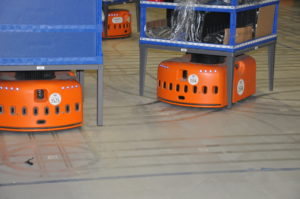Shhh…. Listen closely. You cannot hear them. They are quietly working. They don’t ask for breaks. When it comes to lunch, they are never late. They are hard at work. While a typical third-party logistics operation is typically ALL about labor, this one is not. 
It is ALL about the personalized EACH: the effective picking of the order of ONE. With the rise of social commerce,warehouses are struggling to effectively pick, personalize and ship an order of ONE correctly. Especially, if it is something like guitar strings where they all look alike. If you ship them incorrectly to the guitar aficionados, it will reflect in your negative ratings online, where it matters more and more.
In May, I toured Quiet Logistics in Boston, where robotics are used to tackle the problem. It was founded by Bruce Welty, CEO. I was asked to visit by Greg Cronin, now at Quiet Logistics, who knows how much I love covering new and disruptive technologies. Robotics for picking. I love it. Zoom me up to the new world! But, wait is it a new world, or just an unappreciated disruptive technology that has found a new niche.
A Kiva robot is typically orange in color, 2 feet by 2.5 feet, and one foot high. Each robot weighs around 250 pounds, and can carry four times its weight. The maximum velocity of a robot is 1.3 meters per second. The robots navigate around the warehouse using an onboard camera to read barcode stickers on the warehouse floor. They communicate wirelessly to computer servers that run order-processing software and deliver directions. The solution was launched in 2003 by Marty Mountz, the founder and original CEO of Webvan. However, the adoption rate has been very low. Read on….
The operation for Quiet Logistics went live in April 2009. It is a general use, multi-tenant picking system. Their clients are often online shippers with a problem. When Musicparts.com — a rapidly growing direct consumer business– was struggling with how to ship a growing catalogue with over 500 unique items, they turned to Quiet Logistics. They were tired of getting the negative ratings on on-line reviews for mis-shipments. Let’s face it to the untrained eye, an “A” string looks just like a “G” string. To satisfy orders they had eight pickers that worked eight hours, but had a 10% error rate. With they switched to Quiet Logistics they were able to fulfill orders with one person in one hour with no errors. But, more importantly, they went from ratings SO bad that EBay wanted to shut them down to 220 positive ratings on fulfillment.
When Gilt.com launched their business in May, it was an exercise in extreme fulfillment, ship very fast with ultimate customization for high-end luxury goods. In this unique online presence, Gilt.com buys excess luxury goods, ships them to the Quiet Logistics warehouse, advertises them online to their exclusive community, and then leaves it to the robots to accurately pick them. They come in all shapes and sizes with high-end luxury expectations. The robots are flexible to handle hanging goods; bulky, high-end items; and smaller, high-value items.
Robotics for warehouse picking is not new. However, it just maybe an idea whose time has come. It’s value proposition is flexibility. It comes with a steep price. In this world, where companies value the lowest cost/case as the defacto measurement of supply chain excellence; robotics for warehouse picking is hard to sell. It is one of the many supply chain technologies that has floundered because it is hard to justify. However, readers, the world is changing. With the Rise of Social Commerce– a redefined shopping experience that combines on-line and social technologies to improve the shopping experience–the fulfillment of ONE well will become table stakes. It will not be about the lowest cost per unit. It will be about systems with flexibility for inserts, tailored messages, personalized samples and PERFECT orders everytime. While companies like the GAP, Staples, and Zappos use this technology everyday, it has not been available as a third-party logistics offering. At least, up until now….
The bigger story for me is why supply chain companies cannot reward flexibility in the selection of equipment like robotics for warehouse management. It has not changed much in my thirty years of supply chain experience. I remember a discussion with the Roger Miller, head of manufacturing, for what was then General Foods. I was a plant engineering manager at their largest food manufacturing plant. The proliferation of Jello flavors for puddings and gelatin was skyrocketing. It was a maturing brand. We had a choice to either buy a high speed machine with long runs and long change-overs or a slower machine that could change over quickly, but run at lower speeds. He asked me, “why I was asking the question? Wasn’t the answer obvious? The right decisions was the high speed machine that delivered the lowest cost per case.” At that time, I could not make a compelling argument for the lower speed machine around flexibility. It has taken me thirty years to be able to engage more deeply in speed and efficiency do not deliver the highest value for the value chain. Not then; and certainly not now. But, to be able to see the true beauty in Kiva robotics, and Quiet Logistics as a 3PL, you have to be grounded in how to have the debate.
What do you think? Do you see the rise of robotics for warehouse management with the rise of social commerce?
(Let me include a disclaimer. At Altimeter Group (www.altimetergroup.com), I cover disruptive technologies–of all kinds–that help to improve the supply chain. I am all about covering how new technologies help companies to drive more value in their value chain. Quiet Logistics is not an Altimeter client. I write case studies like this with one goal: coverage of disruptive technologies for the supply chain with a defined value proposition. I am not a pay for play writer. I do not write case studies for a fee. So, please don’t call me up and request one…. )

The Deserted Mall is an Important Symbol for Supply Chain Leaders
Thinking about the pervasive shifts in the technology landscape.





